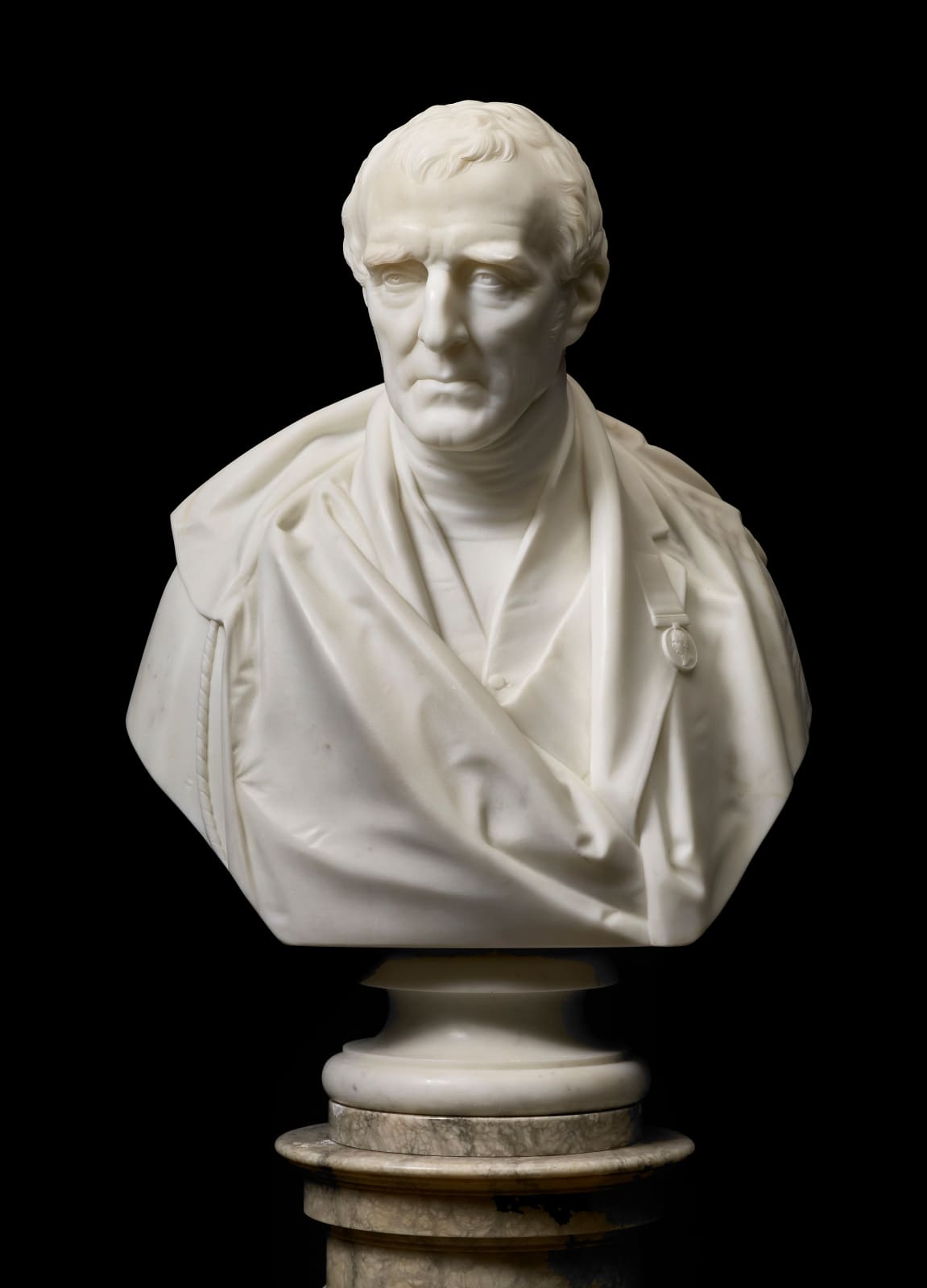
Matthew Noble
This monumental portrait bust of the Duke of Wellington as a statesman is one of the most important sculptures of the Iron Duke to be offered for sale in recent years.
There are only two identified versions of this bust-type dating to 1851. One was recorded in the collection at the Army and Navy Club, London by 1935[1], while the other was offered for sale at Phillips in 1987.[2] The latter example was not as highly finished as the present work, evident most notably in the treatment of the drapery, and the possibility that it was a later version, erroneously dated, cannot be ruled out. The present bust is most likely the Army and Navy Club version which was exhibited at the Royal Academy in 1852.[3] It would, therefore, have been seen by Wellington himself when he visited the exhibition on 28 July 1852. Wellington was the first President of the Army and Navy Club (between 1838 and 1841), and his likeness would have been considered essential for the collection.
There are several recorded later derivations of this bust-type dated 1852, including one in the collection of the Walker Art Gallery, Liverpool. These may well have been produced after Wellington’s death in September of that year. It was presumably also this bust-type that formed the basis of a bronze variant by Noble produced in 1852[4] which was later worked-up into the full-length sculpture of Wellington completed in 1856 and installed in Piccadilly Gardens in Manchester.
Arthur Wellesley, 1st Duke of Wellington, is among the most important and influential military figures in British history, primarily remembered for his victory against Napoleon at the Battle of Waterloo in 1815. During Wellesley’s military career he participated in some sixty battles; initial public recognition came when he was knighted for his efforts in 1805 on his return to England after a long campaign in India. He was made Commander of the British Army during the Peninsular War and was created Duke of Wellington in 1814.
Although Wellington had been involved in politics throughout his adult life, after Waterloo he became an increasingly influential member of the Tory party, culminating in his tenure as Prime Minister from 1828 until 1830, and then again (for less than a month) in 1834. He was subsequently Leader of the House of Lords until his retirement in 1846. Wellington died in 1852 and was buried in St Paul’s Cathedral following a state funeral.
[1] Whereabouts unknown.
[2] Phillips, London, 17 November 1987, lot 155 (unsold), offered again 6 June 1989, lot 220.
[3] A. Graves, The Royal Academy of Arts, A Complete Dictionary of Contributors and their work from its foundation in 1769 to 1904 (London, 1989) p.377, [No.1442]; G. Wellesley, The Iconography of the First Duke of Wellington, (London, 1935), p.38
[4] Government Art Collection
This monumental portrait bust of the Duke of Wellington as a statesman is one of the most important sculptures of the Iron Duke to be offered for sale in recent years, and a welcome addition to his recorded iconography.
Provenance
Probably the Army and Navy Club, London;
Goodnestone Park, Kent, until sold;
Dreweatts Bloomsbury Auctions, Berkshire, 11 November 2015, lot 70;
Philip Mould & Company, acquired from the above.
Exhibitions
Probably The Royal Academy, London, 1852.- X
- Tumblr
This website uses cookies
This site uses cookies to help make it more useful to you. Please contact us to find out more about our Cookie Policy.
Be the first to hear about our available artworks
* denotes required fields
We will process the personal data you have supplied in accordance with our privacy policy (available on request). You can unsubscribe or change your preferences at any time by clicking the link in our emails.
